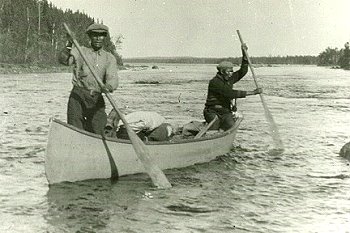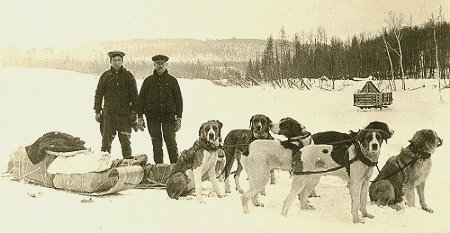|
Back to Presettlement The Fur Trade |

The Valley in the BeginningThe Ojibwe, the Odawa (Ottawa) and Potawatomi were the three main First Nations people who lived around the North Shore. They were all part of the Algonquin Linguistic family, and called themselves Anishnabe, the "original men". Directed by a vision, this nation moved from along the Atlantic Ocean to the Great Lakes around 10,000 years ago. The Potawatomi moved to Lake Michigan, the Ojibwe settled at Bawating at Sault Ste. Marie and at the mouth of the Mississagi River, and the Odawa lived at Michilimackinac and Manitoulin Island. The Ojibwe were the greatest nation of the Great Lakes. They were excellent hunters and trappers, and were usually a peaceful people, although skilled in battle. The Mississaugies, who were a part of the Ojibwe family, had a population of 50 to 150 people who lived as a large group around the mouth of the Mississagi River during the summer. When fall and winter came, they would move to the inner lakes in small family groups. The Mississagi River was called Miswezaging, "river of many mouths", by the Ojibwe. It was later misspelled by the Europeans and named Mississagi. The Ojibwe were very important in the French fur trade. Around the 1600's, they began to get involved in trading with the French. As the Ojibwe became more involved with European trading they became increasingly Europeanised, slowly losing their cultural skills and traditions. Wars With the IroquoisThe Iroquois, who came from the Lower Lakes, attempted to attack the Ojibwe after defeating the Huron. The warring went on for years, but the Iroquois were routed again and again by the Ojibwe, until the Iroquois had finally admitted defeat. The last battle between the Iroquois and the Ojibwe occurred around 1760. Although the Ojibwe did win their part in the war, they left the North Channel in Lake Huron because of the horrible effects of the wars, which included smallpox brought to the area by the Iroquois. After the French had made a peace treaty with the Iroquois, the Ojibwe felt it was safe to return to their traditional lands.  In 1783 the North West Company, a fur trading company, was developed to stop furs being brought to Hudson Bay Company. They sent traders out to deal with the Natives. Trading and supply posts were established in many areas, including Sault Ste. Marie, St. Joseph Island and the Mississagi River. When liquor was introduced to the Natives involved with fur trading, they became increasingly absorbed into the American and British cultures. After the war of 1812, the Ojibwe were treated very badly by the Americans because the Ojibwe had been on the side of the British. As a result of an Indian legend of copper in the Bruce Mines area, Bruce Mines became the first Ontario mining town when copper was discovered in 1846. The Ojibwe began to be pushed out of the area by treaties. New industries began to infringe on the Ojibwe's traditional lands. The Sault locks destroyed homes and fishing areas. Agriculture was introduced to Algoma, and in 1901 there were 4,673 farms. Logging, fishing and shipping all helped to change drastically the Ojibwe ways of life. Around the early 1900's, the Mississagi Forest Reserve was created for the Natives of the area, and there are now several reserves in this area. Return to Top |
Home | Natural Environment | History | Industry | Personalities/Stories | Credits/Team